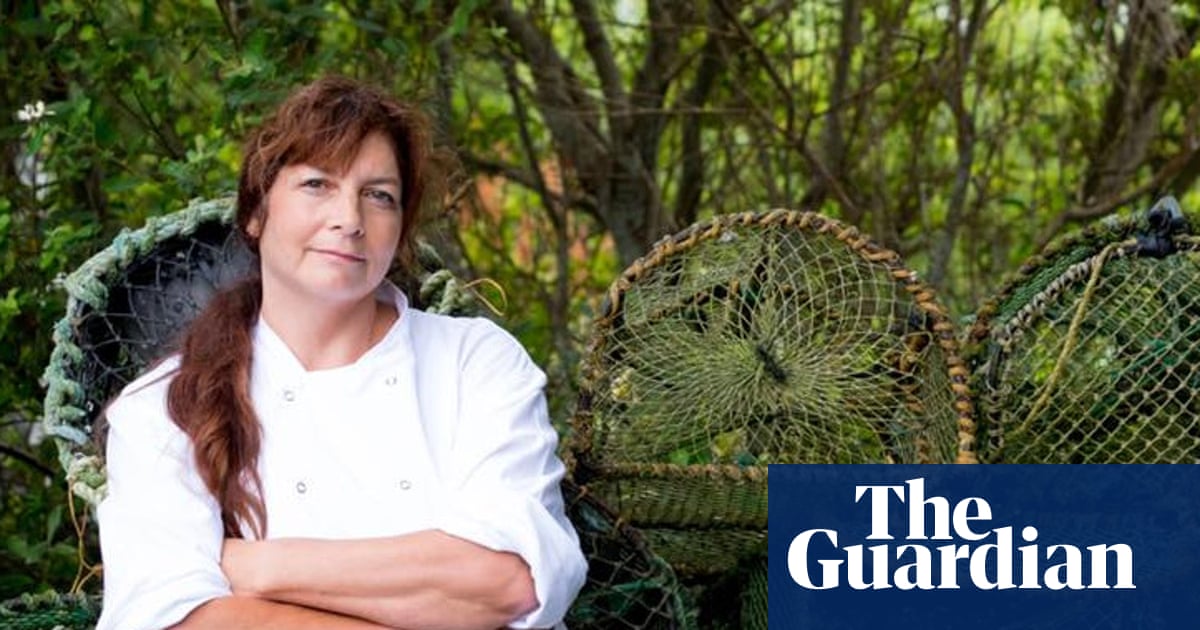Croft originals: the chefs reviving Isle of Mull’s food scene | Food and drink
‘Edible means it won’t kill you – it doesn’t mean it tastes good. This, however, does taste good,” says chef Carla Lamont as she snips off a piece of orpine, a native sedum, in her herb garden. It’s crisp and juicy like a granny smith but tastes more like cucumber. “It’s said to ward off strange people and lightning strikes; but I like strange people.”
We’re on a three-hectare (seven-acre) coastal croft on the Hebridean island of Mull. Armed with scissors, Carla is giving me a kitchen garden tour and culinary masterclass – she was a quarter-finalist in Masterchef: The Professionals a few years back. Sweet cicely can be swapped for star anise, she tells me. Lemon verbena she uses in scallop ceviche.
She points out a barberry bush whose small, sour berries, a Middle Eastern staple, she adds to jewelled rice, and a myrtle bush which, I learn, is different from the bog myrtle growing wild on the croft that, when the leaves are crushed, smells gloriously aromatic with hints of eucalyptus. Bog myrtle also protects your woollens from moths, wards off midges – and is a key ingredient in one of her cocktails.
“I had never grown anything before I came here. I was in a kitchen in the city and herbs came dried in a tub. Now, if I haven’t heard of something, I give it a go or thrust it at Jonny and say ‘Greenhouse.’”
Carla and Jonny, her husband, are part of a new wave of crofter chefs or field-to-fork farmers spreading across Scotland. Crofting is, essentially, small-scale subsistence farming, the crofter traditionally rearing a few animals and growing vegetables on the smallholding, and maintaining a job or two on the side.
Now, just as the architect-designed, off-grid bothy is a world away from the bare-bones huts that once gave shepherds shelter, the croft has been reinvented. Our back-to-the-land yearnings, fuelled by programmes such as This Farming Life and Ben Fogle: New Lives in the Wild, have turned crofting into a modern rural fantasy.
The new generation of crofters still juggle jobs, but today, that usually involves tourism rather than working for the local laird. For Jonny and Carla, it’s a restaurant called Ninth Wave and a cute cabin, the Sea Shanty (sleeps two from £800 a week).
They met 30 years ago when Carla, from Canada, answered an ad for a chef on the neighbouring island of Iona. Jonny’s nickname, Carla smiles, is “the lobster man”. Every day, he hikes two miles cross-country to his small boat, the Sonsie, returning with the catch that Carla cooks in the restaurant. They also cure, smoke and brine seafood and meat on Bruach Mhor croft. When Jonny’s not fishing, he’s working the land.
They grow about 80% of the fruit and vegetables for the restaurant in their kitchen garden, everything from cardoons to wasabi, and forage for wild herbs on the croft. They’ve counted more than 150 seasonal greens, herbs and edible flowers growing wild here. Bumping up the dirt track for lunch, the hedgerow is billowing with fluffy meadowsweet. “I’ll be harvesting it later for panna cotta,” Carla tells me.
“People don’t realise you can eat so many flowers.” The pots of blowsy blooms by the door, it turns out, are also on the menu. “Marigolds are edible and so are dahlias. You can eat the flowers and the tubers. The Mexicans used them as their main starch crop hundreds of years ago. They’re wonderful roasted; like a cross between a potato and a jerusalem artichoke.”
The restaurant was once the barn or bothy, with a dirt floor and tin roof, attached to their one-bedroom cottage. And while the produce for the menu might mainly be locally grown, reared or caught, the inspiration for Carla’s dishes comes from her travels. At the end of each season, the couple head off on food adventures, grazing their way through Latin America, Asia and the Middle East.
For lunch I’m tucking into a Mexican-inspired dish: Jonny’s lobster teetering on garden-grown roasted corn salsa, a creamy Yucatan avocado and hoja santo soup, laced with lemon verbena and Vietnamese coriander. “It’s not fine dining,” she shrugs, “it’s street food presented nicely.”
At the other end of the island, another restaurant on a croft is also making waves as much for its architectural wow factor as its pasture-to-plate menus. Jeanette Cutlack moved to Mull from Brighton in 2008 and ran a pop-up restaurant for 10 years in her home. Her dream, however, was to restore the abandoned croft and ruined barn down the lane.
after newsletter promotion
With the help of an old university friend, Edward Farleigh-Dastmalchi, who founded London-based architects Fardaa, she began work. Croft 3 is now a destination restaurant, the old steading converted into a pared-back, cathedral-style dining space, open to the rafters with bare plaster walls and vast windows framing sea views; the project won a prestigious Royal Incorporation of Architects in Scotland award. Diners eat the simple, field-to-fork menus at long communal tables cut from a single Douglas fir. Starters such as crab arancini and lemon mayonnaise are served alongside spicy haggis, cornbread and salsa verde. Haggis is Jeanette’s speciality and she also runs haggis-making workshops.
Now that the land has been cleared, the 20-hectare croft is starting to bear fruit. Jeanette has planted a nectarine tree and kiwi vine. In a polytunnel, she and her family grow salad and herbs while a small flock of Hebridean sheep grazes the hill that is part of the land. Last September, hogget was on the menu for the first time. What they don’t grow or rear themselves, they source from neighbouring crofts and fishers.
Mull once lagged behind the Hebrides’ culinary powerhouse, Skye, but it’s starting to emerge from its shadow. A food and drink trail around the island highlights a growing number of artisan producers as well as gourmet pit stops such as pop-up turned permanent fixture Ar Bòrd (our table). Iain and Joyce Hetherington have converted their front room into a restaurant showcasing the local produce – from creel-caught shellfish landed at Croig on the island’s north coast, to organic vegetables grown by Carol Guidicelli on her croft at Langamull, near Croig, along with their in-house smoked venison. On the tiny community-owned island of Ulva, meanwhile, a short boat ride away, the Boathouse, recently revamped by Banjo Beale, winner of a TV interior design show, has become one of the hottest lunch spots, with diners crammed around picnic tables devouring plates of briny langoustine and crab claws on the water’s edge.
And then there is the well established but ever-evolving award-winning Sgriob-ruadh farm, where they produce Isle of Mull cheese, just a few minutes’ drive from Tobermory’s pastel-painted waterfront. The Reade family arrived on the island with five cows in the 1980s and rebuilt a rundown dairy operation, starting cheese production a few years later. The farm’s Glass Barn cafe is a fabulous, foliage-festooned space where you can sample signature cheese and charcuterie platters or a bowl of homemade soup and a cheese scone before taking the far from run-of-the-mill tour.
Our small tour group meets the US cheese-maker Troy by the pig pen. After hearing a potted family history, we move on to the milking parlour where he weaves in science and Willy Wonka-style invention. The milk, he explains, is pumped to the cheese-making shed next door via an underground tank. The warm milk, fresh from the cows’ udders, heats the water used by the cafe. Walking us through the cheese-making process, we head underground to the vast cheese cellar, meet newborn calves and piglets and learn about innovative sustainable farming initiatives.
The leftover whey from the cheesemaking was once used to feed the pigs – until they found a better use for it. In the farmyard a smart new micro-distillery uses the whey to make gin and “whey-ski” – possibly a pun too far, a barrel-aged spirit. The tour ends with a tasting. The gin has a surprisingly distinctive creaminess, the whey-ski is pure fire water.
“It’s not sweet like a bourbon,” Troy says as he pours another dram. “It’s more like an Irish whiskey.” I knock it back, thinking that’s the thing about Mull: for outside-the-box thinking and wild culinary innovation, it’s leading the way.
Ninth Wave: four-course lunch £80 (not open for dinner). Croft 3: two-course menu £42, three courses £50. The Boathouse: half lobster £25, langoustines £18 (a la carte). Ar Bòrd: three-course set menu £55pp. Isle of Mull Cheese tour: £20








